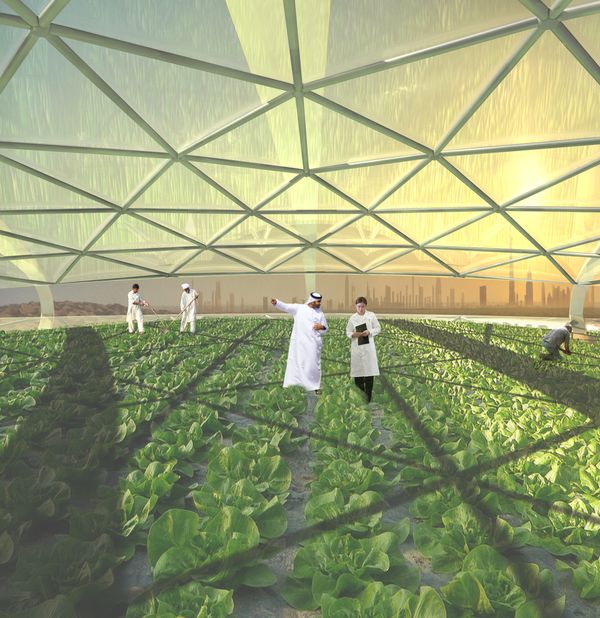Desert Farming: Vertical farms are being built to produce food for urban populations who struggle for space. But now, a new idea has risen: a vertical farm to feed people living in desert environments. The Seawater Vertical Farm is the future farm and it looks mind-boggling, to say the least!


How the proposed Seawater Vertical Farm will look
Vertical farms or “farmscrapers” use greenhouse methods such as hydroponics to grow fruit, vegetables, and mushrooms all year round. Since the idea was first suggested in 1999, the movement has caught on, and there are now many places around the world that are growing food inside buildings in urban environments.
From this original idea comes an even more advanced idea: a new generation of farmscraper has been proposed. The latest design of a vertical farm comes via Italian architect firm Studiomobile, in Venice, Italy. Their aim is to achieve ‘creative sustainability.’
Desert Farming: Vertical style
The architects plan to design a farmscraper for desert environments, and they plan to use desalinated water to quench its thirst. They are just the right firm to do this, seeing as they have been working in the United Arab Emirates, developing housing and infrastructure projects in the dry conditions the area is famous for.


How the proposed “seawater farmscraper” will look
There are some large problems to overcome in this part of the world:
The lack of fresh water
The growth in demand for water and increasing shortages of supply are two of the most certain scenarios of the 21st century. Agriculture, accounting for some 70% of all water used, is a major pressure point. Fortunately, the world is not short of water, it is just in the wrong place.
Desalinisation
Abu Dhabi has five large desalination plants that consume a lot of energy. A cubic metre of fresh water produced by the desalination technology called reverse osmosis requires a litre of fuel. This means desalination is responsible for the release of large amounts of gas which contribute to climate change.
The lack of space
The world population is expected to increase to 9.2 billion in 2050. About the 70% of the world population will live in cities. Huge urban areas, especially on the coast, will need a large amount of food and fresh water.
Transport
The food and agricultural sector is responsible for more than one-third of global greenhouse gas emissions. Refrigeration makes up a large part of this. In addition, the cost of transporting crops from the country to the city weighs upon the food price. Growing crops near where they will be eaten would cut the cost and the gas emissions.


The Seawater Vertical Farm from above
Desert Farming: The Seawater Vertical Farm
The Seawater Vertical Farm uses seawater to cool and humidify greenhouses and to convert sufficient humidity back into fresh water to irrigate the crops. Converting seawater to fresh water in the right quantities and in the right places offers the potential to solve all the problems described above.


The Seawater Vertical Farm is planned for Dubai. It is in places like this that local people battle with a lack of fresh water. Growing local vegetables is almost impossible, due to poor soil and water availability. And, it has awful urban traffic, which makes transporting food from more fertile areas to the city areas a problem. But a seawater urban farm would solve this.


The design of the Seawater Vertical Farm is quite simple. It provides five cocoon greenhouses fixed to five branches that transport and nebulise the seawater.


Desert farming, using desalinated seawater.
This creates a humid and cool flow, ideal for the plants, like the environment of the equatorial forest. In these conditions, crops need very little water as they are not stressed by excessive transpiration.
And it also would make a fantastic tourist destination. Deserts of the world, prepare for a new future! Humans are coming for you, and fast.





